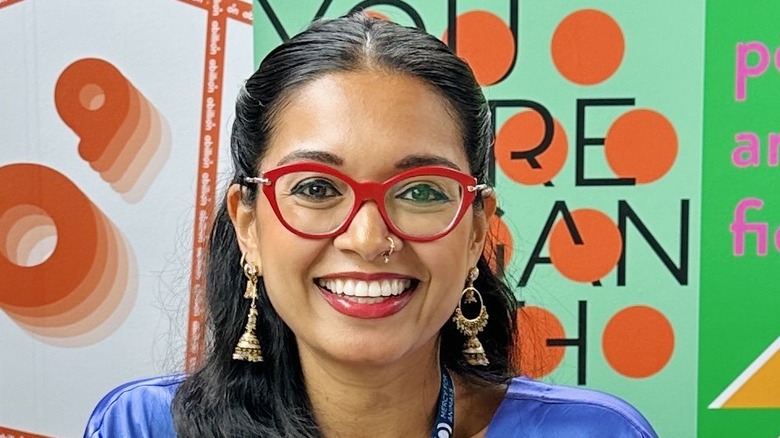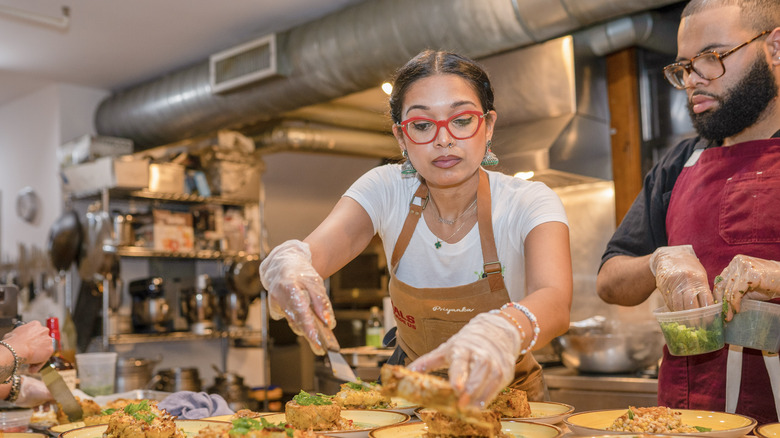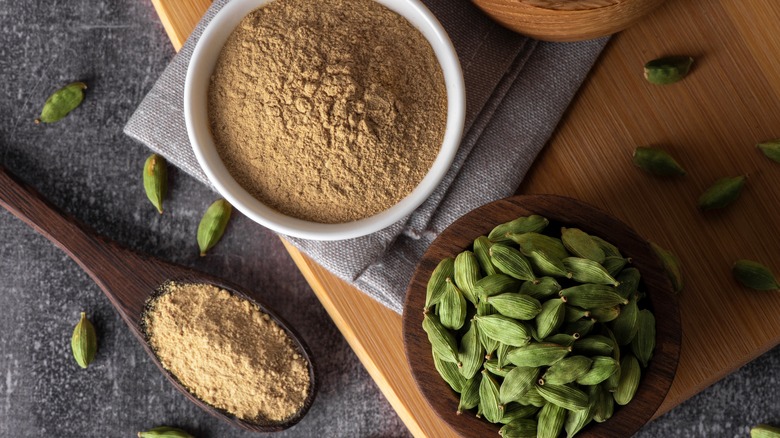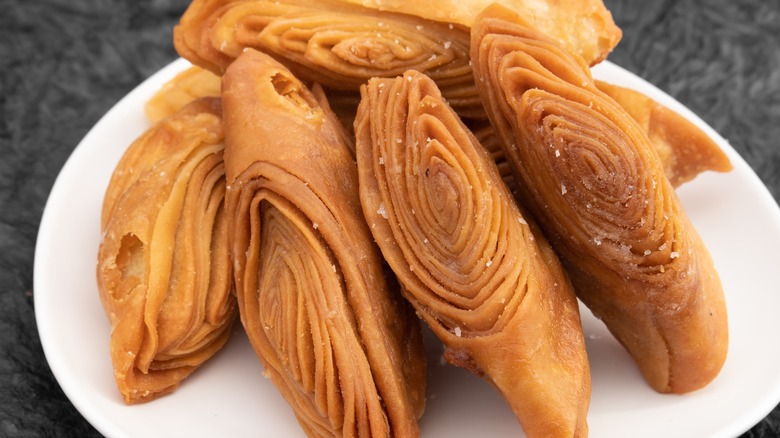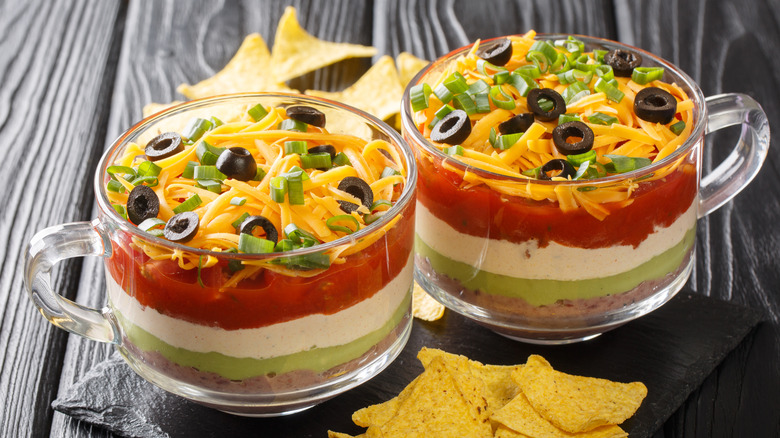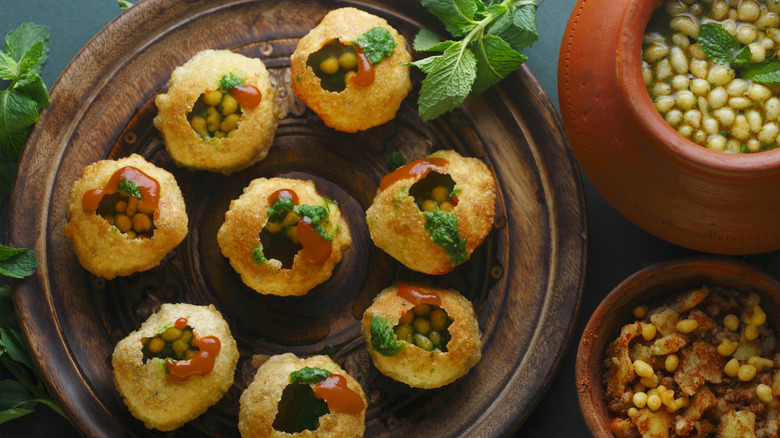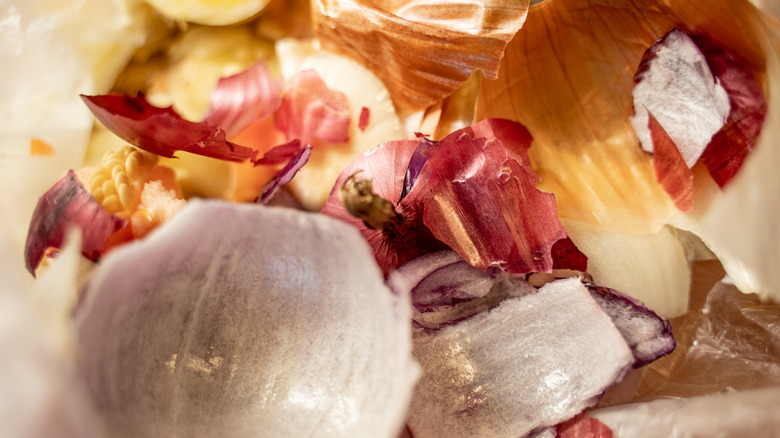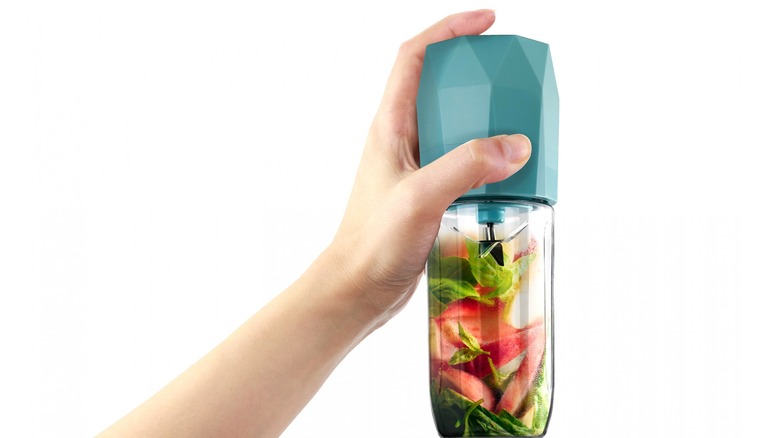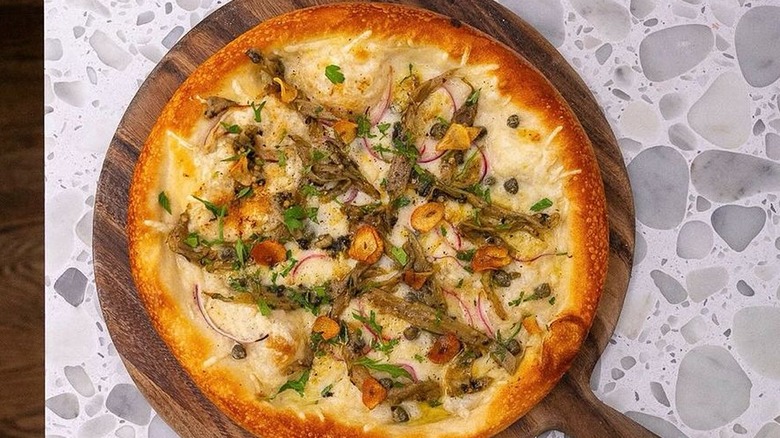Priyanka Naik Wants You To Know That Plant-Based Cooking Isn't Afterthought - Exclusive Interview
Priyanka Naik is out to prove that vegan food can be fun and flavorful. Despite plant-based cooking rising to prominence, the author of "The Modern Tiffin" still finds that many have a narrow view of vegan food. Naik combines her Indian heritage and love of international cuisine to bring new flavors to kitchens across the world.
Naik's food is just as colorful and perfectly harmonious as her appearance. Pairing dragon fruit-shaped earrings with a colorful fruit-patterned shirt, she brings brightness to any room, even in these cold months. Now, Naik will bring her unique cooking style to sunny Florida for FoodieCon at the South Beach Wine and Food Festival.
Recently, Tasting Table got the chance to speak with Priyanka Naik about a few things. While we touched on the SOBEWFF and her upcoming cooking demo and book signing at Williams Sonoma in New York City, Naik also shared about her favorite ways to reduce waste in the kitchen and get some vegan food recommendations.
Starting plant-based
What are you most looking forward to at FoodieCon?
I'm pretty excited for FoodieCon. I was supposed to be in it last October in New York, which would've been fitting because I live here; I'm from here. But I was traveling. This will be my first FoodieCon. To be honest, I'm most looking forward to meeting a lot of people that I haven't met in person by now, but we've been connected either through social media or through being authors or doing some sort of TV work together in a very virtual way.
I would say the second thing that I'm most excited about is currently the FoodieCon lineup; this year, I'm the only vegan and South Asian chef. I think for me, that's almost like I'm representing the vegan community and the South Asian community. I hope this is an opportunity to kind of make those two aspects of who I am, kind of shed new light on it through FoodieCon and SOBEWFF, and also just make it more fun and approachable.
For people who are just starting out with plant-based cooking, what advice do you have?
For people starting out with plant-based cooking or are new to the style of cooking, I would say explore a new vegetable every week. I think many times what happens is, especially in America, vegetables and plant-based or vegan, vegetarian food are always an afterthought or they're always considered the side dish and not the star of the show.
I always advise people to explore their produce aisles and pick a new vegetable every week. One week can be eggplant; another week can be cauliflower. A week after that can be spinach. You've probably eaten these vegetables all in some way or some form throughout your life.
But really picking that vegetable and making an actual dish out of it where it's the star of the plate can not only bring new recipes to their repertoire but also change their perspective on that particular vegetable. I would say for four weeks, pick a new vegetable every week and think about what you can make and refer to your favorite chefs, your favorite blogs, TV shows, and kind of build your recipe repertoire for those plant-based dishes based on those vegetables.
Whole spices vs ground spices
Walk us through your pantry. Beyond the basics, what are some of the underrated items you always have on hand?
Whole dried spices. This is probably a function of me being Indian. I think we generally, across the Indian subcontinent, regardless of what region you're from, there's always the use of whole spices in some way.
Whether it's actually using that whole spice or grounding it down. I think it really elevates any dish and it takes especially vegan, vegetarian food to a whole other level. I think in the Western world, vegetables not only, as I said, are an afterthought or a side dish, but they're not really dressed up. Whole spices last a pretty long time. They're inexpensive if you buy them at an Asian or Indian grocery store, and they can really take a dish from bland to grand.
What are some of the benefits of using whole spices versus ground spices?
I usually stay away from ground spices unless it's like ground turmeric or ground chili powder. The reason being, once you grind a spice down, there are natural oils in that whole spice — just like there would be in nuts — and it immediately starts losing its flavor. It could go rancid, and it's not shelf stable for as long as whole spices would be. The other reason is, within Indian and South Asian cooking, we temper whole spices a lot.
You wouldn't be able to get the same effect if you used ground cumin versus using the whole cumin seed. It would just burn the spice, versus when you put a whole spice in hot oil, it blooms, and it lets out those natural oils and flavors. It can be much more economically friendly. If you buy a bag of whole coriander seeds versus ground, you're getting much more bang for your buck. You can use it whole, semi-ground, or ground. I tend not to really buy ground spices.
Indian desserts
What are some of your favorite go-to Indian desserts?
I would say a lot of my favorite go-to Indian desserts are probably not mainstream. It's a function of the type of Indian I am. I'm Maharashtrian, so we are from the state of Maharashtra, which is Mumbai and then a little bit south. The type of cooking and style we eat is really just not readily available in restaurants in the U.S. at all.
One is called chirote, which is generally made during Diwali. It's made with all-purpose flour-based dough. You essentially make this thin dough, and you roll it out, and you keep layering it almost like a croissant, but there's no butter in between each layer. You keep layering it, and then you make these little rounds. Now, it's like a layered mini disc, and you fry it, then all of those layers sort of puff up. It could be served one of two ways. You could leave it crispy and put powdered sugar over it. The way we make it at home is we'll take that crisp of Diwali and soak it in a saffron, cardamom sugar syrup. They're very decadent and sticky and crispy at the same time.
Another one is called sheera. It could be referred to also as payasam. You take semolina, and you toast it. Once it's toasted — we put cashews and cardamom and saffron and you toast it — and then you can add water or milk. We usually add water, then you let it cook, and it's kind of like a thick porridgey consistency, but not as liquidy. We'll also add chunks of pineapple in there. You let it cook, and then you kind of scoop it out into a bowl, and you could top it with more nuts and cardamom. It kind of has a texture between a porridge and a thick grits. It's usually made during religious festivals and stuff, but it is quite good.
Favorite appetizers
When time is short, what are some of your favorite foods to make, especially using canned ingredients?
I travel a lot, and many times, I just will not have produce and stuff in my house. But I come home, and I want to cook something. I always keep some sort of noodles or rice on hand that I can cook up quickly. I rely a lot on the Momofuku noodles. They cook up really quickly. The quality is great. But what I will do to add nutrients, protein, and fiber to that is I'll always have some sort of aromatics on hand because ginger and garlic can stay for a pretty long time in your pantry.
I'll add some sort of nuts like cashews or peanuts for some protein and a bit of flax seed, which are again a healthy fat and are very highly nutritious. Then, many a time, I'll add some sort of canned bean or legume. What I'll do is make a big batch of dry beans, soak it overnight, cook it, and then freeze it. Once it's frozen, it's basically like I've made my own beans from scratch. Then I'll add that to my noodles. So now I have fiber and protein and vitamins, and so I can make a meal pretty much in 10 or 15 minutes without actually using any fresh produce.
With Super Bowl LVIII coming up in a few weeks, what suggestions do you have for a crowd-pleasing vegan appetizer?
I grew up on seven-layer dip. My mom would make it all the time. It's a crowd-pleaser, especially when you layer it and you put it in a clear dish; it's very visibly appealing. It's really easy to veganize because pretty much all of the components in there, except for the sour cream and cheese, are vegan.
The beans, guacamole, and salsa are vegan, and there are so many great substitutes now for vegan sour cream and vegan mayo. I'll just substitute the sour cream layer with vegan sour cream. Then I'll just use my favorite non-dairy shredded cheese on top. Many times, I'll make it the morning of or even the night before because when it soaks in, it actually tastes better, and it's easily transportable. The other thing is there's always some sort of negative stigma associated with vegan foods still in 2024, but when I serve this dish, people don't know that it's vegan at all.
The other one is sheet pan french fry nachos. Take your favorite waffle fries or french fries and lay them on a sheet pan, bake them or air fry them, and then just put your favorite toppings on. The reason why I love this dish is because I literally take it from the sheet pan, from the oven to the table. I don't transfer the fries to another dish. The sheet pan becomes the serving plate.
Fun with panipuri
At the SOBEWFF coming up, going to be focusing on panipuri. Why is this a fun snack for you?
As mentioned, we're from Mumbai and a little bit South. In that area, we have a lot of dishes which we refer to as kachara pachara, which literally translates to junk food, or kachara can translate to trash. But the naming of that is it's essentially street food. In Mumbai, a lot of the types of dishes and foods we eat are based on this very casual snacky way of eating. Panipuri is a one-bite item.
You obviously can eat as many panipuris as you want, but the fun thing about it is it's almost instant gratification. You have to eat it quickly. If you don't, it's going to get soggy. I'm a messy eater, and it just kind of fits into the mold of who I am. The filling of panipuri could be anything you want. It's traditionally potatoes and some sort of black chickpea or legume and turmeric chutney, fresh cilantro, and coriander. The pani, which is the sweet, salty, spicy water, is the main thing. You dip it in, and you eat it. I just think it's really fun.
It's very representative of who I am, and I've actually served it at pop-ups that I've done. It's been the most popular item that people have eaten on my menus. I just like to have fun with food and also showcase like, "Hey, this dish is literally vegan by default." Y'all, it's like there's the sort of negative stigma that vegan food gets. I feel like I'm trying to dismantle that through showing these fun cultural items.
You mentioned that it's a versatile item, so do you have any non-traditional ingredients you like to use?
Yes. At my last pop-up in LA, which I do with Cafe Gratitude, we did the filling with a Mexican-inspired elote inside, and then dipped with the traditional pani spicy tamarind chili water that I made. I also love fusing together different cultures. That's really my style of cooking. Bringing together that Mexican flair and those Indian spices really sort of elevated the panipuri and showcased how versatile it really can be.
Saving in the kitchen
You created the Ecokitchen newsletter series. What are some of the easiest ways someone can conserve energy and reduce waste in their kitchen?
Tthe one thing that people can do is repurpose leftovers and compost. People always get bored with eating leftovers. I need to eat a different type of food every day. But that doesn't mean that I should ignore or waste what's already in my fridge. If I go out to eat and don't pack that food ... I just can't wrap my head around someone doing that because that's not only wasting food and bad for the environment, it's literally money down the drain.
One thing that people can always do is repurpose leftovers. Taking old rice, making burgers, making fried rice, grounding it down, and making a rice pudding out of it. There are so many things you could do, like composting. I live in Manhattan. I obviously do not have a backyard, and I also don't have the ability to keep one of those composter things in my apartment. What I do is I freeze my scraps and I then take it to a local farmer's market. There are tons all over the city, and there's always a compost bin, and I compost right there. It goes back to those local farms and communities.
What are some of the surprising parts of food that can be eaten that are often discarded?
Literally, all parts of fruits and vegetables can generally be eaten: carrot tops, potato peels, beet greens, and cauliflower leaves. When you get a cauliflower head, it comes with all of those leaves, and they're automatically thrown out. I used to throw it out; everyone does.
Then I actually tasted a little bit of the leaf once, and I was like, "This is pretty good. I feel like I'm wasting half of the head of cauliflower by throwing this whole thing out." I ended up blanching the leaves, blending them down into a sauce that I made for the saffron-marinated cauliflower steaks. There's so much creativity behind what you can do with the scraps.
And again, if you don't care about the environment, you do care about your wallet. If you buy these carrots and you have these tops, you're paying for all of that; why would you throw them in the trash? Many times I'll just take the carrot tops, I'll make sure to thoroughly wash them, crisp them up in an air fryer and use it as a garnish or eat it like the way you would eat kale chips.
Also peels. Pomegranate peels, banana peels, all of these things can be eaten. Pomegranate peels can be dehydrated and then blended down to a powder, and then you can use that powder in smoothies, in bowls, just as a garnish. Peels of ginger, onion, garlic. Most people probably don't know that when you go and get onion powder or garlic powder at the grocery store, what that really is, is the onion or garlic peels, dehydrating them, and then blending it down into a powder.
Tools of the trade
What tools do you think every kitchen needs?
I would say a good blender because you can make anything from chutney and sauces and smoothies and help chop vegetables and stuff. And I don't even have a Vitamix, so I'm not even talking about that. I have a Magic Bullet. I think one that has high power and can make things really smooth.
Mortar and pestle. This one seems a little bit unnecessary, but it's my favorite tool in the kitchen. It's essential. A mortar and pestle can be used in so many versatile ways. So, as mentioned, I use a lot of whole spices. So when I need to grind those spices, I generally use a mortar and pestle because you can control how much of it you grind and the texture of it. You can make guacamole in a mortar and pestle, you can make chutneys, you can make Thai curry paste. I think mortar and pestle are widely used across the world in so many different ways, and I think they're a really great tool to have in the kitchen.
I would say a really good knife because I think one of the reasons why people generally shy away from cooking is a lot of the prep work and cutting of vegetables. But if you have a good sharp knife that you maintain really well — don't put your knife in the dishwasher, hand wash it, make sure to sharpen it and hone it — it makes your life a lot easier. You can cut all of those onions and garlic and vegetables in a fraction of the time than you would with a blunt knife.
International cuisine
You travel all over the world. Is there a food locale that you think deserves more attention?
I think one that really stood out to me was Sydney, Australia. I knew that the produce and stuff was going to be good there because they obviously have the environment and the land to grow everything on their own continent, and they rarely, they hardly do any importing. I was really blown away by the diversity in food and just the emphasis on plant-based eating and also just the quality of food at restaurants.
Because of their proximity to Southeast Asia, I think that led them to have a lot of diverse population and then diverse food. Like Malaysian food, Indonesian food, Indian food, all of that there was amazing. I wouldn't be able to get that type of food in New York. I was really blown away by the variety. I had a macadamia nut milk there, and it was so good.
It truly tasted like macadamia nuts that have been milked, which I feel like if I drank macadamia nut milk here, it would kind of taste watered down, and the quality would be different. The fact that I went into every restaurant and I didn't have to ask, "Oh, do you have any vegan items or plant-based items?" It was all very prominently on the menu. It was integrated like it was part of their life. It wasn't an afterthought.
Being vegan in New York
When you're in New York City, what are your go-to vegan spots?
I would say one of the completely vegan restaurants that I love is Coletta, which is by Chef Guy Vaknin. They're actually across the street from me, but he has several restaurants in New York. He even started Beyond Sushi, but Coletta is a more upscale Italian restaurant. The dough is excellent.
I've tried almost all of the dishes, and they're really elevated. The quality is amazing. I've taken up all my non-vegan friends there, and they were like, "Wow, this is so good." I'm born and raised on Staten Island, so I'm a little biased towards really enjoying Italian food because I've grown up on it. Another restaurant that I really like that's not 100% vegan, but they have vegan options very prominently available is MáLà Project.
MáLà Project is a Sichuan dry pot restaurant. Instead of hot pot, which is you have the broth and they bring you the food, and you dip it, dry pot actually has a similar base or this masala mix that they saute all of the food in. So you kind of pick your additions. You pick the proteins and the veggies that you want and the noodles, and you say the spice level that you want.
I get extra spicy. They saute everything up together; it's served with rice. I eat very spicy, so this totally fits the bill of bold spice and unique vegetable offerings like lotus and all different types of potato and noodles. [MáLà Project] is really accessible to everyone with any sort of dietary restrictions.
What does your order look like at those restaurants?
At Coletta, I like the buffalo chicken pizza. They put shaved celery on it. It's just a very elevated take on ... buffalo chicken pizza, obviously vegan. Then at MáLà Project, my bowl is usually five-spiced tofu, cauliflowers, sweet potato, glutenous rice balls, broccoli, basically a whole bunch of vegetables, and peanuts. Then I get it extra spicy and I order the purple rice on the side. I get purple rice because the texture is a little bit different than white. It's smoother. It's a little bit more like al dente, so it changes the experience when you eat it.
The South Beach Wine and Food Festival will be February 22-25, 2024. Purchase tickets at SOBEWFF.org.
